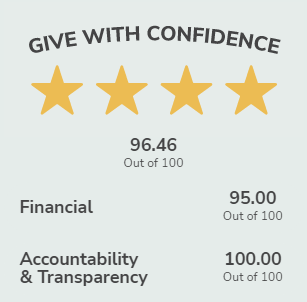Friends in Philanthropy
Our Articles
News Roundups
Get the Newsletter
The Ultimate Charity Ratings Guide for Donors (2-Part Series)
Here’s everything you need to know about using sites like Charity Navigator to make more informed giving decisions

When you see a restaurant has 5 stars on Yelp, you know what that means: customers love the place.
But what about when you see a nonprofit has a “4-Star Charity” badge on its website? You can guess someone thinks this organization is well run. But who gets to decide that? The people who support the charity? The people it serves? Government regulators? Someone else?
And how do they decide? What do sites look for when rating charities? Where do they even get their information?
Then there are the real questions. What do charity ratings actually mean for me as a donor? How should they influence my decisions? And which charity ratings sites should I trust?
These might seem like simple questions. But once you dig in, you realize how hard interpreting charity ratings can be.
So in this two-part guide for donors, we’ll cover everything you need to know about charity ratings to make more informed giving decisions.
In Part Two, we share lots of practical tips: the most popular charity ratings sites to check, what their scores really mean, and how to use them to guide your support.
But first, let’s explore how the charity rating process works and why it matters.
Part 1: Why Charity Ratings Matter for Donors
What are charity ratings and why do they matter?
On a basic level, charity ratings sites like Charity Navigator and BBB Wise Giving Alliance exist to prove credibility. As a donor, you want to know your gift won’t go to waste.

Screenshot of Charity Navigator’s Advisory warnings, which flag nonprofits
suspected of misconduct and other issues.
So, in ascending order of complexity, charity ratings help you to…
1) Spot outright fraud.
Unfortunately, charity scams are far from rare. According to a report from the U.S. Department of Justice, there were about 350,000 victims of charity fraud in 2017. That makes it the second-largest category of financial fraud.
The good news is phony charities are relatively easy to spot. The Federal Trade Commission recommends several watchdog sites that help you tell if a charity is legitimate before you make a gift. (You can also use the IRS’s Tax Exempt Organization Search Tool to see if your gift will be tax-deductible.)
2) Ensure responsible handling of your gifts.
Just because a nonprofit is authentic, that doesn’t automatically mean it manages its funds responsibly. But bad behavior is much harder to hide if nonprofits follow basic transparency practices.
So one major function of charity watchdogs is confirming organizations have safeguards in place to prevent waste and abuse. See the section below on “Accountability and Transparency” to see what practices ratings sites look for in this area.
3) Assess impact.
As you might imagine, calculating a charity’s “impact” is far more complicated than confirming it files the right paperwork every year. In fact there’s quite a bit of debate over the right way to measure the results nonprofits deliver.
Still, wise donors want to see signs their gifts are making as much difference as they can. We’ll cover some ways ratings sites get at this question in the section below on “Impact and Results.”
Send me Friends in Philanthropy
One monthly email. Five great stories from around the web. Get the free newsletter for serious givers of faith and stay in the conversation.
What factors influence charity ratings?
Each watchdog site uses a different formula for rating charities. But they all generally look for the same signs that an organization is well-run.
Factor #1: Accountability and Transparency

Ratings sites want to ensure charities disclose key information to the public at regular intervals. They also want to confirm charities are governed in ways that encourage honest decision making.
These standards help prevent corruption and push organizations to behave responsibly and effectively.
To obtain a high rating in this area, a charity may be required to:
- Establish a Board of Directors with at least 5 members
- List board members and key staff publicly
- Hire an independent accountant to audit its financial reports
- Retain records properly
- Disclose CEO pay
- Avoid financial red flags, such as diverting assets for unauthorized purposes
- Document board meeting minutes
- Establish proper policies around conflicts of interest, whistleblowing, and donor privacy
Factor #2: Financial Health and Efficiency

Watchdogs want to make sure a nonprofit will remain solvent long-term. They also want to know the nonprofit’s budget prioritizes delivering on its mission.
So to score highly here, a charity typically needs to:
- Spend the bulk of its budget on “program expenses.” Standards vary, but think 65%-75% at minimum, with the best-rated charities topping 90%.
- Minimize spending on “overhead.”** Watchdogs typically discourage charities from spending heavily on administration and fundraising. (But see the note below on why this is up for debate!)
- Raise funds efficiently. The website CharityWatch considers an organization “highly efficient” when its “cost to raise $100” is $25 or less.
- Maintain a healthy financial outlook. Charity Navigator looks at both a nonprofit’s “working capital ratio” and its “liabilities to assets ratio.” These measures speak to the charity’s ability to weather economic downturns.
- But also, avoid hoarding wealth. Charity Navigator also looks favorably at “program expense growth”—increasing spending on services year over year. Similarly, BBB Wise Giving Alliance docks a charity for holding too much money in reserve. In both cases, the idea is that charities should prioritize spending on programs over amassing assets.
** A NOTE ON “OVERHEAD”
Some critics (like Vox) argue that drawing strict lines between “program” and “overhead” costs can be misleading. They point out that charities can’t function without management, office space, and so on. They also say punishing charities for spending on indirect costs like training can stop them from investing in their own growth.
However, others insist it’s important for charities to budget efficiently. For now, at least, the ratio of “program spending” to “overhead” is still a major part of most charity ratings.
Factor #3: Impact and Results
https://www.youtube.com/watch?v=FDmo6niOQaI
Charity Navigator’s intro video for its “work in progress” Encompass Rating System, which attempts to incorporate impact and other new factors
In recent years, there’s been a push for ratings sites to evaluate the actual outcomes nonprofits deliver, not just how they operate. The idea is that simply tracking how nonprofits spend their money doesn’t tell you whether their programs actually work.
But impact remains stubbornly hard to measure. For instance:
- How exactly do you calculate the impact of a food pantry? Do you factor in that food insecurity affects health, education, economic opportunity, and much more?
- How do you fairly compare nonprofits in completely different sectors, like a hospital and an art museum?
- And of course, how do you process the mountains of data it would take to rate the nation’s 1.6 million nonprofits on these measures?
One way to solve this problem is to avoid judging impact directly. Instead, for example, BBB Wise Giving Alliance simply verifies that a charity has its own methods to share its results. That way donors at least have some way to decide for themselves whether a nonprofit is working effectively.
For now, this area remains under development. In 2020 Charity Navigator launched its points-based Encompass Rating System, a supplement to its familiar star-based ratings. This new system considers factors like impact, community ties, and even “adaptability.” But it’s still in a beta phase, and it’s not clear how accurate it is at identifying the best nonprofits.
Time will tell if monitor sites can find better ways of rating a charity’s impact using one straightforward score.
How do charity monitors come up with their ratings?
Each year, most nonprofits must file a special form with the IRS to prove they should keep their tax-exempt status. It’s called Form 990, and it asks for detailed info about revenue, expenses, employee pay, and more. The full version runs more than 80 questions, though smaller nonprofits can qualify for shorter forms.

Fortunately for donors, the IRS makes these disclosure forms public. That makes 990s an extremely useful resource for rating charities.
Indeed, popular ratings sites like Charity Navigator rely heavily on 990 forms. Of the 24 factors that determine Charity Navigator’s star ratings, 19 are based on info taken straight from a nonprofit’s 990.
Here are a few other ways watchdogs might assess a charity:
- Reviewing its website. Part of Charity Navigator’s transparency rating is based on a website audit to see how easy it is to find key information.
- Requesting submissions. The nonprofit profile site GuideStar allows nonprofits to supply their own materials for public review, including strategic plans and results metrics.
- Monitoring complaints. Charity Navigator issues official Advisories when it receives reports of alleged misconduct from third-party experts. And BBB Wise Giving Alliance lets the public file complaints about charities directly on its website.
Continue on to Part 2
Now that you’re clear on all this context, you might be wondering about more practical questions: Which charity ratings sites should I be checking? How do I interpret their scoring systems? And how should I use their ratings to make decisions?
For answers, check out the conclusion of our two-part series:
Click here to read Part 2: How to Use Sites Like Charity Navigator to Make Decisions.
Keep up with the philanthropy conversation
One monthly email. Five stories from around the web. Get the Friends in Philanthropy newsletter sent straight to your inbox.
Want a newsletter preview? Check out the Friends in Philanthropy archive:
Kinship United is a 501(c)(3) charitable organization recognized by the Internal Revenue Service. Contributions are tax-deductible to the fullest extent of the law.
EIN: 36-4395095
Kinship United often posts content and opinions that are of interest to the philanthropic community that supports Kinship United’s mission. Nothing published by Kinship United constitutes an investment recommendation, nor should any data or content published by Kinship United be solely relied upon for any investment, tax, legal or financial decisions. Kinship United strongly recommends that you perform your own independent research and/or speak with a qualified investment professional before making any financial decisions.






